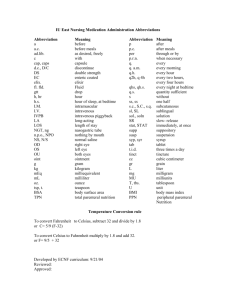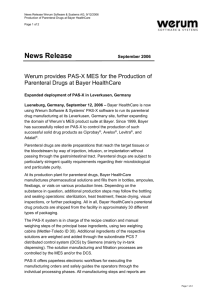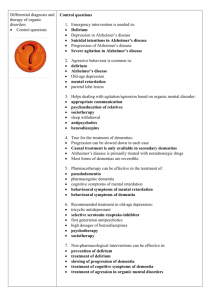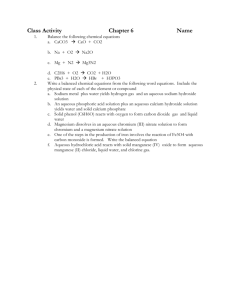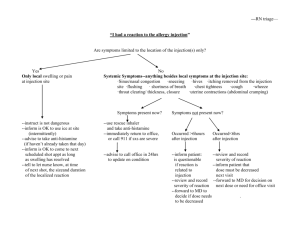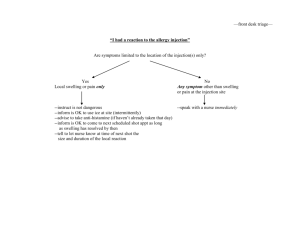LECTURE (2) COMPOSITION OF PARENTERALS
advertisement
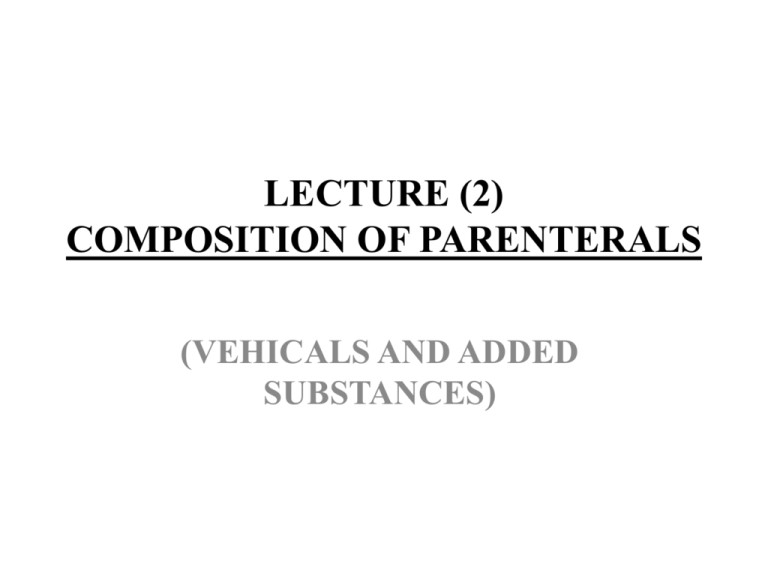
LECTURE (2) COMPOSITION OF PARENTERALS (VEHICALS AND ADDED SUBSTANCES) I. VEHICLES FOR INJECTIONS: 1. Aqueous Vehicles: • 1-WATER FOR INJECTION: • • • • • • • • Most frequently used for parenteral formulation Purified water underwent distillation or reverse osmosis Total dissolved solids not more than 1mg in 100ml No added substances. It has no smell and color. May not be sterile Pyrogen free For products to be sterilized after preparation Must store in tight container at suitable temperature (no microbial growth) • Must be used within 24 hour • Collected in sterile & pyrogen free container (glass or glass lined). • 2-WATER FOR PARENTERALS: • Is simply water for injection which is sterilized without having antimicrobial agent. Is used as a vehicle for all the aqueous parenterals. • 3-STERILE WATER FOR INJECTION: • Water for injection which has been sterilized & packed in container of 1 Liter or less • Pyrogen free • No antimicrobial preservation or added substances • Due to sterilization may contain slightly more solid content (leaching of solids from the glass-lined tanks) • Intended to be used as a solvent, vehicle or diluent for already sterilized & packed injectable medications. • Must be added aseptically. • Used for reconstitution of multiple antibiotics containers.(have no tonicity). • 4-BACTERIOSTATIC WATER FOR INJECTION: • Addition of 1 or 2 antimicrobial agents to sterile water for injection results in bacteriostatic water for injection. • The anti microbial agent must be compatible with the API which will be added in future. Filled in vials/syringe in volume not more than 30ml. • Name & concentration of preservative must be stated • Intended for small volume injectables (multidose vials) • Not to be used with large volume parenterals (usually with 5ml or less) • Concern chemical compatibilities. • 5-WATER MISCIBLE VEHICLE: • As name suggest, this occupies some part of the vehicle and it helps in decreasing hydrolysis and to solubilize some drugs. Ex: Ethyl alcohol, Propylene glycol • 6-SODIUM CHLORIDE INJECTION, USP: • • • • Sterile, isotonic NaCl in water for injection No antimicrobial agent Used as vehicle in preparing solutions/ suspension for parenteral administration. The Na and Cl ion contents of the injection are approximately 154 mEq of each/ liter. • 7-BACTERIOSTATIC SODIUM CHLORIDE INJECTION, USP: • • • • • Sterile, isotonic NaCl in water for injection Contain one or more antimicrobial agents (specify in label) Volume not more than 30 ml (5ml preferred) Concerns compatibility between antimicrobial and the active drug. Not for use in newborns (Due to potential toxicity of benzyl alcohol in newborns, Bacteriostatic Sodium Chloride Injection, USP, 0.9% containing benzyl alcohol as antimicrobial agent must not be used in newborn • • • • 8-RINGER’S INJECTION: Sterile solution of NaCl, KCl, CaCl2 in water for injection Concentration as physiological concentrations Can be used as vehicle or electrolyte replenisher or fluid extender • 9-LACTATE RINGER’S INJECTION, USP: • NaCl, K Cl, CaCl2 & Na lactate • Intended to be used as fluid & electrolyte re-plenisher & systematic alkalanyzer • NaCl is present at 0.9% conc. to render the solution isotonic Suitable vehicle properties • No irritation, sensitization, toxicity or pharmacological activity • Should not affect the activity of the drug • Should have suitable physicochemical properties for intended use (stability, viscosity, fluidity with temperature, boiling point, miscible with body fluid, low vapor pressure) • Purity (ease of purification & standardized) • Must remain clear at 10oC • NB: • ACTIVE INGREDIENTS and other excipients should be pure enough to dispense them as parenterals. • The non pyrogenic materials increase it’s characteristics by the end of process. • Chemically the drug molecule should be pure and the microbes, endotoxins should be within the limits. • Even the trace amount of impurities cause instability. 2. NON AQUEOUS VEHICLES • ■ Non-aqueous vehicles are employed for the production of: • 1. Non-aqueous parenteral solutions of therapeutic agents that are water-insoluble • 2. Non-aqueous parenteral suspensions of therapeutic agents that are water-soluble and/or exhibit aqueous instability • 3. The internal phase of parenteral emulsions. • ■ Fixed oils are predominantly used as non-aqueous vehicles (e.g. corn oil, cottonseed oil, peanut oil, sesame oil etc….), vegetable oils should be used as they can metabolize and they will remain in liquid state at room conditions. • Ex: Corn oil, Peanut oil, Cotton seed oil. These are used for hormone and vitamin preparations. ; however, nonaqueous esters may be used, e.g. ethyl ethanoate. • –Sesame oil is generally the oil of choice as it is more stable • –Oils must be free from rancidity and must not contain mineral oils or solid paraffins. • ■ Two major problems associated with the use of nonaqueous pharmaceutical solutions are: • –Pain/irritation on injection. It should be noted that the viscosity of fixed oils increases at lower storage temperatures. This will, in turn, affect the ease of administration by injection and the pain/irritation at the site of injection. It is essential to ensure that the viscosities of oil-based solutions and suspensions are minimized both to reduce pain on injection and to enhance the ease of administration (injection). • Fixed oils should be properly characterized: purity, iodine number, saponification number. • The label must state the specific oil present (allergic reaction). • Intramuscular administration & not IV (oil globules will occlude the pulmonary microcirculation) • • • • • • • • • Glycerin PEG Propylene glycol Alcohol Less common Ethyl oleate, isopropyl myristate, dimethylacetamide No paraffin oil (not absorbed) Must be safe in the amount administered Do not interfere with therapeutic activity of the drug Intramuscular administration • Acceptable Co-solvents: • Co-solvent LD50 Advantages Disadvantages ----------------------------------------------------------------------------- • • Glycerin 6ml/kg Insulin products Low solvent power • other protein • Ethanol 2g/kg High solvent power Painfull • Used @ 10% • Propylene 8g/kg Stable Moderate solvent power • Glycol Used @ 40-60% • Very wide use • Polyethylene 8g/kg Smillar to PG Viscous • Glyc Low irritation Peroxides • Dimethyl3g/kg Excellent solvent Toxicity • acetamide II. ADDED SUBSTANCES FOR PARENTERALS • These include the substances that safeguard the purity of the formulation. • Purposes: • - Maintain sterility • - Maintain stability • - Minimize Pain & Tissue irritation • - Establish, Maintain & Control Solubility • -Miscellaneous: Bulking Agent, Suspending Agent, Viscosity Imparting Agent, …. 1- ANTI MICROBIAL AGENTS (Preservatives) • - USP suggests the addition of bacteriostatic, fungistatic and antimicribials to parenteral formulations. Its concentration in parenterals should be enough that they should not allow micro organisms development when the product is drawed and during the usage. • - Aqueous preparations which are prepared using aseptic precautions and which cannot be terminally sterilized may contain a suitable antimicrobial preservative in an appropriate concentration. • No antimicrobial preservative is added when: • The volume to be injected in a single dose exceeds 15mL unless otherwise justified • The preparation is intended for administration by routes where for medical reasons an antimicrobial preservative is not acceptable • If the drug formulation itself has sufficient antimicrobial activity. • Preservatives are incorporated into parenteral formulations whenever: • ■The product is a multidose preparation. In this, several separate doses will be removed from the same container; the inclusion of preservatives is necessary to control microbial growth due to microbial introduction into the product. • ■The product has not been terminally sterilized, e.g. by irradiation or heat. In this situation the preservative is required to guard against any possible breakdown in the aseptic manufacturing process. In all other situations the presence of a preservative is deemed unnecessary. • -Examples of preservatives employed in parenteral formulations include: • ■Esters of parahydroxybenzoic acid, e.g. methyl and propylparahydroxybenzoic acid are often used in combination in a ratio of 9:1. The concentration is usually circa 0.2% w/v. • ■phenolic compounds, e.g. phenol (0.25–0.5% w/v) or chlorocresol (0.1–0.3% w/v). Formulation considerations for the inclusion of preservatives into parenteral formulations include the following: • ■ In aqueous parenteral suspensions and in some aqueous parenteral solutions hydrophilic surfactants (included to enhance/maintain the solubility of the therapeutic agent or to ensure the physical stability of the formulation over the proposed shelf-life) may interact with esters of parahydroxybenzoate. In so doing the effective concentration of preservative and hence the preservative efficacy are decreased. This problem is resolved by increasing the concentration of preservative (generally up to 0.25% w/v). • ■ Preservatives may similarly interact with the container and closure of the parenteral product, necessitating an increase in the concentration of preservative required or, preferably, a change in the type of container closure. • For example, phenol has been shown to interact with rubber closures. In this situation, rather than increasing the concentration of phenol added, the rubber closure may be exchanged with a suitable replacement, e.g. nitrile closures. • It is essential that the preservative does not adversely affect the chemical and physical stability of the parenteral product. • For example, as insulin formulations are usually multidose preparations, preservatives are required to inhibit microbial contamination of the product. The physical stability of zinc insulin is compromised in the presence of phenol (but not methylparahydroxybenzoic acid). • ■ In the preservation of parenteral emulsions, the formulation scientist must be aware of the ability of the preservative to distribute between the inner oil phase and the outer aqueous phase. • The preservative is required in the aqueous phase of the emulsion to exert the antimicrobial effect. • Distribution between the two phases will therefore decrease the concentration of preservative in the aqueous phase and, accordingly, reduce the preservative efficacy. • To overcome this, the concentration of preservative in the dosage form should be increased. This may be easily calculated by consideration of the partition coefficient of the preservative between the oil and aqueous phases and the solubility of the preservative in the two phases • ■ Oil-based parenteral products (solutions and suspensions) do not generally require the inclusion of a preservative due to the low water activity of this medium. • ■ The potential toxicity of preservatives must be considered when formulating parenteral products in light of the greater potential toxicity of preservatives when administered parenterally. It is therefore desirable to avoid the inclusion of preservatives whenever possible. • -The effectiveness of antimicrobial agents can be tested by challenging the product with selected organisms. The test procedure will evaluate the antimicrobial activity of the preservative in the packaged product. • Commonly used anti-microbial agents in paranteral preparations • • • • • • • • • Anti-microbial agent Benzalkonium Chloride Benzyl alcohol Chlorobutol Phenol Chlorocresol Phenylmercuric salts Methylhydroxybenzoate Concentration used (% w/v) 0.01 1-2 0.25-0.5 0.5 0.1-0.3 0.002 0.1-0.2 2. ANTIOXIDANTS: • -Many drugs in aqueous solutions are easily degraded by oxidation, a process involving the addition of an electronegative atom or radical or the removal of an electropositive atom, radical or electron. • -Oxidation may occur due to the action of molecular oxygen; however, this is a slow process, especially in aqueous solution in which the concentration of dissolved oxygen is low. Alternatively oxidation may be facilitated by free radicals, with breakdown occurring via a chain reaction process. • -Radicals are formed due to the action of light, heat or transition metals (e.g. iron, copper) that are present in the formulation. • -Several important classes of therapeutic agents may undergo oxidative degradation, including phenothiazines, polyene antimicrobial agents, steroids, morphine and tetracyclines. • -Antioxidants are included in paranteral formulations to slowdown or inhibit oxidative degradation of therapeutic agents. • These agents either act by: • Preventing the formation of free radicals (Block oxidative chain reactions) (Ascorbic acid esters, BHT (butyl hydroxy toluene & Tocopherols ). • They are strong reducing agents and are therefore oxidized in preference to the therapeutic agent (Preferentially oxidized) ( (e.g.). : (Ascorbic acid, Na. metasulfate, sodium-metabisulphite, sodium formaldehyde sulphoxylate). • -Furthermore, chelating agents, e.g. ethylenediamine diacetic acid, may be added to extract dissolved transition metals, thereby reducing their ability to generate free radicals or to be involved in electron transfer reactions. • -A further strategy that may be used to enhance the stability of the therapeutic agent is to flush the injection container/vial with nitrogen prior to closure. In so doing oxygen is removed from the headspace within the packaged product. Although successful, the limitation of this approach is the availability of specialised filling equipment that will provide satisfactory gas purging prior to closure of the product. • - Small volume parenteral containing these drugs (under go oxidation) often contain an antioxidant. • - Bisulphites and metabisulphites are the commonly used antioxidants in aqueous injections. • -Antioxidants must be carefully selected for use in injections to avoid interaction with the active drug. • - Combination of antioxidants and EDTA is more effective. • -Oxidative degradation can be minimized by the use of antioxidants and when this course is not feasible, the products may be sealed in an inert atmosphere of nitrogen or carbon dioxide. 3. BUFFERING AGENTS • -Formulations must maintain the intended pH. Changes in the pH of a product may occur during storage because of: • Degradative reactions taking place in the product (proteins) • Interaction of the product with the components of the containers. • Dissolution of gases and vapors. • Buffers are commonly included in parenteral formulations to control the pH of the formulation. • Control of the pH of the formulation may: • ■ Maintain the solubility of the drug in the vehicle over the shelf-life of the preparation. • Importantly, if there is precipitation of the therapeutic agent within a parenteral solution during storage, the preparation can no longer be referred to as a solution and thus the shelf-life of the product has been reached. • Furthermore, the IV administration of a parenteral solution in which there is precipitated drug may lead to a blockage within the capillaries, with the associated deleterious effects on the organ to which the blood would normally be transported. • ■ Enhance the chemical stability of the therapeutic agent by maintaining the pH of the formulation within the range of optimum chemical stability of the therapeutic agent. • -Examples of commonly used buffers include acetic acid/sodium acetate, citric acid/sodium citrate and sodium phosphate/disodium phosphate 4. SURFACE ACTIVE AGENTS • ■ Surface-active agents may be incorporated into parenteral solutions to enhance the solubility of the therapeutic agent to the required concentration. • In this case, the concentration of surface-active agent employed will exceed the critical micelle concentration (CMC) of the surface-active agent. • Surface-active agents may be incorporated into aqueous or non-aqueous (oil-based) vehicles for this purpose. • ■When included in parenteral suspension formulations, surface-active agents act to enhance the physical stability of the formulation by adsorbing to the surface of the dispersed therapeutic agent and preventing caking of the solid particles. • For this purpose concentrations of surface-active agents that are below the CMC may be used. • It is extremely common for non-ionic surface-active agents to be used in this manner. Examples include: • –Polyoxyethylene sorbitan fatty acid esters (Tween series), within the concentration range of 0.1–0.5% w/v • –Poly(oxyethylene)-poly(oxypropylene) block co-polymers (Poloxamers), within the concentration range 0.01–5% w/v • –Lecithin, within the concentration range of 0.5–2.0% w/w. • ■The choices of surface-active agent and the concentration to be used are dependent on the nature of the vehicle and the type of parenteral formulation (i.e. solution or suspension). • Accordingly surfactants with low and high hydrophilic– lipophilic balance values will be used to stabilize oilbased and aqueous drug suspensions, respectively. • Similarly, these surfactants are used to solubilize drugs in oil- based and aqueous vehicles, respectively; in this case higher concentrations (˃CMC) are required. • ■The use of surface-active agents to solubilize therapeutic agents is commercially employed. Examples of these formulated systems include: • –Steroids have been solubilized for parenteral use using combinations of non-ionic surfactants, e.g. polyoxyethylenesorbitan fatty acid esters (Tween series) and sorbitan esters(Span series). • –The poorly water-soluble vitamins (A, D, E and K) may be solubilised using surface-active agents as parenteral solution formulations. For example, phytomenandione is formulated as a colloidal solution in a mixed-micelles vehicle and is designed for administration either by slow IV injection or by IV infusion (after incorporation within a 5% glucose solution). • –The poorly water-soluble antifungal agent amphotericin B is commercially available as a complex with sodium deoxycholate (Fungizone), L-a-dimyristoylphosphatidylcholine and L-adimyristoylphosphatidylglycerol (Abelcet), sodium cholesteryl sulphate (Amphocil). • These powders are constituted with water for injection to produce colloidal solutions prior to use as IV infusions 5. VISCOSITY IMPARTING AGENTS • Polymers to modify formulation viscosity and/or drug solubility: • The inclusion of polymers within parenteral suspensions occurs more frequently than in paranteral solutions. • In parenteral solutions the inclusion of hydrophilic polymers will increase the viscosity of the formulations, which may in turn result in difficulties in administration. • It must be remembered that during administration the formulation must flow through the narrow pore of the injection needle. Under these circumstances small changes in formulation viscosity will be amplified during the passage through the needle. In addition increased formulation viscosity may result in pain at the injection site. • Whilst hydrophilic polymers may be added to solutions designed for oral administration to increase the viscosity, e.g. to aid the accurate measurement of a dose on the measuring spoon/cup, this requirement is unnecessary for parenteral solution formulations. • Therefore, the inclusion of hydrophilic polymers in parenteral solution formulations is restricted to aqueous solution to enhance the solubility of therapeutic agent by complexation e.g; PVP. It is present in aqueous tetracycline and aqueous oxytetracycline injections for veterinary application • Molecular weight of PVP that is employed in the formulation of parenteral solutions is low (circa 12, 000) and this, in conjunction with the linear nature of this polymer in aqueous solutions, ensures that large concentrations (up to 18% w/v) may be used without the viscosity of the resultant formulation being excessive for clinical use. • • Lipophilic polymers are rarely, if ever, used to solubilise therapeutic agent in oil-based vehicles for parenteral administration. • As stated previously, if required the solubility of drugs in the oil-based vehicle may be enhanced by the incorporation of surfactants (e.g. sorbitan esters, Span) or co-solvents, e.g. benzyl benzoate. • • When used in aqueous suspensions, hydrophilic polymers maintain the physical stability of the formulation by a number of mechanisms: • Stearic stabilization: In this the polymer chains be adsorbed on to the surface of the dispersed drug particles and, in so doing, the close approach of two particles is stearically inhibited. The presence of the adsorbed hydrophilic polymer is sufficient to prevent the two particles interacting at the primary minimum. • In addition, if the polymer is a polyelectrolyte (e.g. sodium alginate), the polymer chains may effectively form a bridge between two particles when in the presence of an oppositely charged divalent or trivalent ion. The ion provides an effective charge on the surface of the particles, with which the charged polymer chain interacts. In so doing the two particles are maintained/stabilised at distances greater than the primary minimum. • Considerations in enhancement of the viscosity of the formulation: • - As previously defined, the physical stability of suspensions is dependent, at least in part, on the rate of sedimentation of the suspended particles (Stokes’ equation). • -In addition the rate of sedimentation is inversely related to the viscosity of the formulation. • -The presence of hydrophilic polymers in parenteral suspensions will increase the viscosity of the formulation and will therefore act to stabilise the formulation. However it must be remembered that, as the viscosity of the formulation is increased, the ease of administration decreases and likelihood of pain up on injection increases. Therefore, the concentration of hydrophilic polymer that may be used for this purpose (and hence the viscosity achieved) is limited by these potential clinical limitations. • -The physical stabilization of aqueous paranteral drug suspensions is usually achieved by the incorporation of surface-active agents and/or hydrophilic polymers. • It should be noted that the range of surfactants and hydrophilic polymers that may be used in this fashion is lower than for comparator preparations designed for oral administration. This is primarily due to the potentially greater toxicity of excipients following parenteral administration • -The stabilization of oil-based suspensions for parenteral administration is generally not performed using (lipophilic) polymers due to their limited availability. Instead the physical stability of oil-based systems may be effectively enhanced using salts of fatty acids or fatty acid esters, which primarily increase the viscosity of the formulation. Examples of these include: • ■Aluminium salts of stearic acid (e.g. aluminium stearate, aluminium distearate, aluminium tristearate). These are normally prepared by dissolving the required concentration of aluminium salt (up to 5%, depending on the salt type) into the oil vehicle at high temperatures (circa 165°C). Upon cooling the drug may be dispersed into the rheologically structured vehicle. • ■Trihydroxystearin (Thixcin). This may be dissolved in the oilbased vehicle without heating and, in a similar fashion to the example above, produces a rheologically structured vehicle into which the therapeutic agent may be dispersed 6. TONICITY CONTRIBUTORS • - Osmolarity refers to the mass of solute that, when dissolved in1 liter of solution, will produce an osmotic pressure equivalent to that produced by a one-molar (1 mol) solution of ideal unionized substance. • - An isotonic solution is one that exhibits the same effective osmotic pressure as blood serum, whereas hypotonic and hypertonic solutions refer to solutions in which the osmotic pressure exerted by the solution is less than and greater than blood serum, respectively. • -The tonicity of paranteral formulations is an important design criterion. In the presence of a hypotonic solution, red blood cells will swell (due to water entry into the cell) and eventually burst (termed haemolysis) whereas, in the presence of a hypertonic solution, water will leave the red blood cells, leading to crenation. • -Ideally the administration of parenterals and in particular the IV administration of parenteral should be isotonic (circa 291 mosmol/l) to avoid potential damage. However, many parenteral products designed for IV administration are hypertonic. Products within the osmolarity range of 300–500 mosmol/l may be administered by the IV route rapidly (with care being taken with formulations at the higher extremes of this range to ensure that administration is slower). • - IV fluids may be profoundly hypertonic, e.g. the tonicity of Hyperamine 30, Sodium Bicarbonate Intravenous Infusion BP (4.2% and 8.4% w/v) is 1450, 1000 and 2000 mosmol/l, respectively. Clinically this does not present any problems as these fluids will be administered to patients by a central venous line in which the infusion rate is slow and the infusion is rapidly diluted within the blood stream. • -It is recommended that parenteral formulations designed for IV administration should not be hypotonic. • Therefore, hypotonic solutions should be rendered isotonic by the addition of compounds that will increase the osmotic pressure of the solution. • Typically sodium chloride or dextrose is used for this purpose. • There are two methods by which the mass of these compounds required to render the solution isotonic may be calculated: • (1) Consideration of the gram-molecular concentration; and • (2) Consideration of the freezing-point depression of the solution. 1. Gram-molecular concentration • ■The gram-molecular concentration refers to the number of moles of substance in 100 grams of solvent. • ■For example if 1 gram molecule (mole) of a non-ionic compound is dissolved in 100 grams of water, the gram-molecular concentration is 1%. • ■As osmotic pressure is a colligative property, the number of moles of substance in solution is important. Therefore if 1 mol of NaCl is dissolved in water, 2 mol of ions are produced. • ■A solution is isotonic whenever the gram-molecular concentration is 0.03%. • ■The following three examples show how this may be used to produce isotonic solutions. • Example 1: Calculate the concentration (% w/v) of dextrose (molecular weight 180 g/mol) that should be added to water to produce an isotonic solution. Dextrose is non-ionic and therefore 1 mol of dextrose when added to 100 grams of water will produce a gram-molecular concentration of 1%. • Therefore: 0.03x180 = 5.4%w/v • Example 2: Calculate the concentration (% w/v) of sodium chloride (molecular weight 58.5 g/mol) that should be added to water to produce an isotonic solution. Sodium chloride is ionic and therefore 1 mol of NaCl, when added to 100 grams of water, will produce a gram-molecular concentration of 2%. • Therefore: (0.03x58.5)/2= 0.9%w/v. • Example 3: Calculate the concentration of sodium chloride that must be added to a 1% solution of lidocaine hydrochloride (molecular weight 270 g/mol) to render this isotonic. Initially the grammolecular concentration of the drug solution must be calculated (remembering that 1 mol of lidocaine hydrochloride dissociates to produce 2 mol of ions). The above equations must be rearranged in terms of the gram-molecular concentration. • Thus: (2 x1/270) = 0.007% . As this is less than 0.03%, the reader will observe that a simple solution of lidocaine hydrochloride (1% w/v) is hypotonic. The gram-molecular percentage that must be added to correct this imbalance is therefore: 0.03- 0.007 =0.023%. Therefore, the concentration of sodium chloride required to render this solution isotonic is : (0.023x58.5/2) =0.67%w/v. 2. Freezing-point depression • ■The inclusion of ions in a solvent will lower the freezing point of that solvent: the extent of the depression of the freezing point is dependent on the number of ions in solution. This is a basic colligative property. • ■An isotonic solution exhibits a freezing-point depression of 0.52°C • ■Therefore the solution of drug should be adjusted to produce a freezing-point depression of 0.52°C to render the solution isotonic. • ■Tables are available which provide the freezing-point depressions for various compounds. • ■The following are two examples of the use of this technique. • Example.4: Calculate the concentration (% w/v) of sodium chloride that should be added to water to produce an isotonic solution. The freezingpoint depression of a 1% solution of NaCl is 0.576°C (derived from tables). Therefore, the concentration of sodium chloride required to render a solution isotonic is: (0.52/0576)x1=0.9%w/v. • Example 5: Calculate the concentration of sodium chloride that must be added to a 1% solution of lidocaine hydrochloride (freezing-point depression of a 1% solution is 0.130°C) to render this isotonic. Initially the freezing-point depression for the 1% solution of drug is calculated: 1x0.130=0.130°C. Therefore the difference in freezing-point depressions of an isotonic solution and the described drug solution is:0.52 - 0.13 = 0.39°C. The freezing-point depression of a 1% w/v solution of sodium chloride is 0.576°C. This allows the calculation of the required mass of sodium chloride to be added: (0.39/0.576) = 0.677g. Cryoprotectants • Stabilize and prevent degradation of drugs, espacially proteins, from effect of freezing. Freezing may denature some proteins. • Protein naturally go from native (N) state to a Denature (D) state N ←---→ D • The addition of a stabilizer causes an increase in protein chemical potential arising from the preferential exclusion of the stabilizer from the protein surface. Binding of these stabilizers to protein is thermodynamically unfavorable process. If the protein were to denature (unfold), it would require greater contact surface between the protein and excipient and augment this thermodynamically unfavorable state. Stabilizers force the above reaction to the left thermodynamically. • A hydration shell is maintained around the protein molecules which reduces the denaturing effect of freezing. • Cryoprotectants – Sugars: Sucrose, Lactose, Glucose, Trehalose – Polyols: Glycerol, Mannitol, Sorbitol – Amino Acids: Glycine, Alanine, Lysine – Polymers: PEG, Dextran, PVP These molecules will increase the tension at the interface between the protein molecules and the solvent and thus, will be preferentially excluded. Because of this exclusion, the protein hydrates and stabilizes. Lyoprotectants • Substance which protect drugs espacially proteins from degradation during drying (dehydration). • Two mechanisms – Water replacement theory: a good stabilizer serves as a water substitutes by hydrogen-bonding to the dried protein. – Vitrification theory: the protein and stabilizer are both amorphous glasses immobilized together where the stabilizer protect the protein from degradation. • Example: – Sugars: Mannitol, Lactose, Maltose, Maltodextrin, Trehalose, Sucrose – Amino Acids: Glycin, histadine, arginine Parenteral emulsions: • Under certain circumstances, emulsions are employed as parenteral formulations. Emulsions are disperse systems in which one immiscible liquid is dispersed in another liquid. Whilst two forms of emulsion exist, water in oil (w/o, in which water droplets are dispersed in an oil phase) and oil in water (o/w, in which oil droplets are dispersed in an aqueous phase), it is the latter type (o/w) that is usually administered parenterally. • Examples of the paranteral use (past and present) of emulsions include: • ■The subcutaneous administration of allergenic compounds in a w/o emulsion was performed by Freund & McDermott(1942) to enhance the resultant antibody response. • ■The IM administration of o/w emulsions to provide controlled drug release. • ■The IV administration of o/w emulsions as total paranteral nutrition emulsions. In these, 10–20% oil is emulsified within an aqueous phase using phospholipids and lecithin surfactants to stabilise the emulsion. The emulsion is rendered isotonic by the addition of glycerol and glucose. The oils are subsequently broken down to triglycerides that provide essential fatty acids and act as a source of calories for patients who cannot consume food orally • There are several problems associated with the use of parenteral emulsions that have restricted their pharmaceutical use: • ■There is a limited list of surface-active agents that may be employed to stabilise parenteral emulsions (due to toxicity concerns). • ■When administered intravenously it is essential that the droplet size is less than 1μm to prevent blockage of blood flow within the capillaries. The physical instability of emulsions, which normally causes the droplets of the internal phase to coalesce, is therefore a potential dangerous consequence of a poorly formulated emulsion. • ■Emulsions are difficult to sterilize. Normal sterilization methods, e.g. heat and filtration, are generally inappropriate. • Approaches to Solve Problems with Pain Upon Injection • • • • • • • Adjust isotonicity Modify chemical structure Slow injection/infusion rate Dilute drug concentration Adjust pH Filter the infusion Remove formulation ingredients

